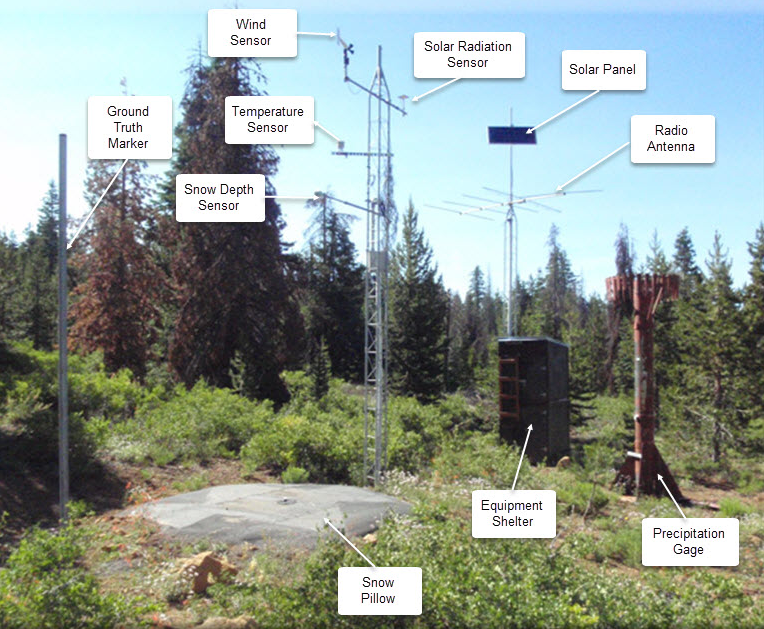Course Video Content - Unit 2
1/21
Earn XP
Description and Tags
snow, ice formation and accumulation
Name | Mastery | Learn | Test | Matching | Spaced |
|---|
No study sessions yet.
22 Terms
Snowpack temperature gradient
Temperatures further down in the snowpack are generally warmer than those at the top, due to less atmospheric exposure. Heat flux moves upward. Pore spaces far down hold more vapor where high ones hold less, thus basal snowpack has higher vapor pressure than surface pack.
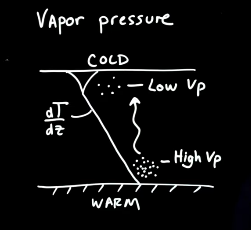
How does vapor pressure change in relation to the temperature of the air above snowpack?
If temperatures are very cold throughout of the snowpack, there will be less variation as you move downward due to it being harder to move below freezing. As a result, vapor pressure does not vary too much between top and bottom. However, if temperatures are warmer at the base, you would expect to see a more normal, significant gradient between high vapor pressure (bottom) and low vapor pressure (top)
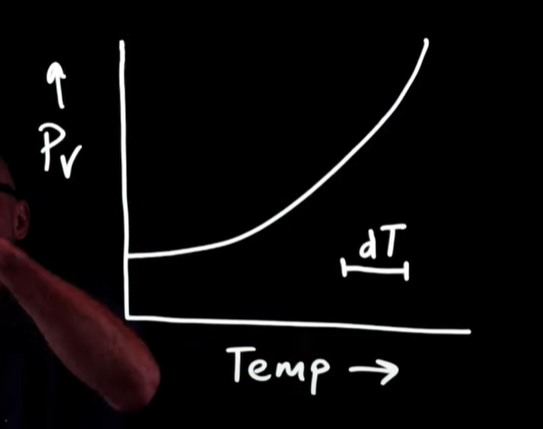
Describe vapor movement in between grains in snowpack.
Long distance flow. This is the movement of vapor through air space between grains
Hand to hand transport. The air around crystals lower in the snowpack will be warmer, and thus have higher vapor pressure than those just above them. This means that water molecules will move upwards, settling in the airspace of the upper grain. A molecule that was already there will then accrue to the upper grain to balance out the addition
These processes are also synonymous with heat flow. Water molecules release latent heat when absorbed into the crystal
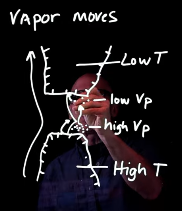
What are heat/mass flow between grains in snowpack dependent on?
grain geometry; the shape and size of the grain. Open, well-connected frameworks will move mass more effectively than tight, poorly connected ones.
snow density; high densities cause fewer pore spaces, making heat movement only possible by conduction
temp/vapor pressure gradient; higher gradients allow more movement than lower ones
temperature range; a warmer temp range encourages more VP difference and movement of heat/mass than very cold, small temperature ranges
Describe how vapor moves in relation to the curvature of a grain.
The vapor pressure above a convex part of the grain is much higher than the pressure above concave surfaces. This is because pointed surfaces are more unstable and require higher pressure to hold molecules in, whereas curved, subsided surfaces do not (stronger H2O bonds). Because of this, pressure will attempt to migrate to a lower spot (concave, more stable), where molecules will accumulate, thus removing mass from the convex part of the grain.
Eventually, pointed snow crystals will eventually become rounded due to the movement of vapor pressure.
True. Molecules are encouraged to move from higher, unstable points to lower, more stable ones. This can take many weeks.
Describe the stability of new snow in relation to old snow.
New snowflakes have many more pointed edges and a wider surface area, least stable due to more broken H2O bonds. Old snow becomes smaller, rounded, and more stable through vapor movement, and thus has the minimum amount of broken bonds. Older snowpack has much more uniform composition
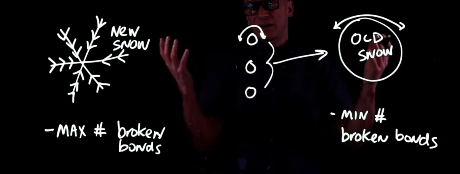
Describe how a low temperature gradient changes snow metamorphism.
With a small temperature gradient, there less movement of heat and vapor pressure between grains. What matters is crystals’ curvature; molecules will accumulate between the pointier ends of grains, fusing them with strong bonds (sintering). This creates rounded grains that are more stable, and snowpack that is very strong.
Grains are referred to as “equilibrium form” or “rounds”
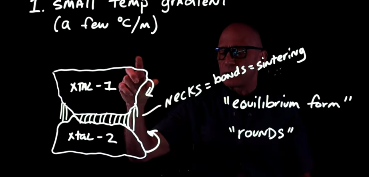
Describe how a high temperature gradient changes snow metamorphism.
With a high temperature gradient, there is more movement of heat and vapor pressure between grains. Bottom is warm while the surface is cold. Since vapor pressure is higher at the bottom, vapor moves upward, growing faceted, square-like crystals that aren’t bonded to one another. Due to this, snowpack is very weak/loose
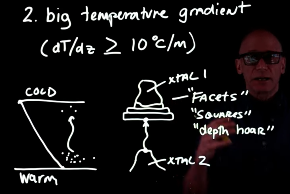
What are the requirements for weak snowpack (faceting)?
A temperature gradient of 10 degrees C per meter
warm temperature; warmer temp means high vapor flux while lower temp means the opposite. Facets grow more quickly with warmer temperatures
low density of snowpack; lower densities favor vapor diffusion (high temp gradient) while higher ones favor conduction (low temp gradient)
Formation of surface hoar
Might happen on a cold, clear, humid night. The atmosphere holds moisture, and will absorb radiation coming out of the snowpack. It will then re-radiate it back to the surface through clouds, keeping the snow surface warm. However, if there are few clouds present, more heat is lost from the snowpack than gained. As a result, the snow surface gets colder, creating an air boundary above the pack that is high pressure. This holds existing molecules in and attaches molecules that are hovering in the air boundary to the surface snow. The result is small, pointed, feathery crystals that are loosely bound
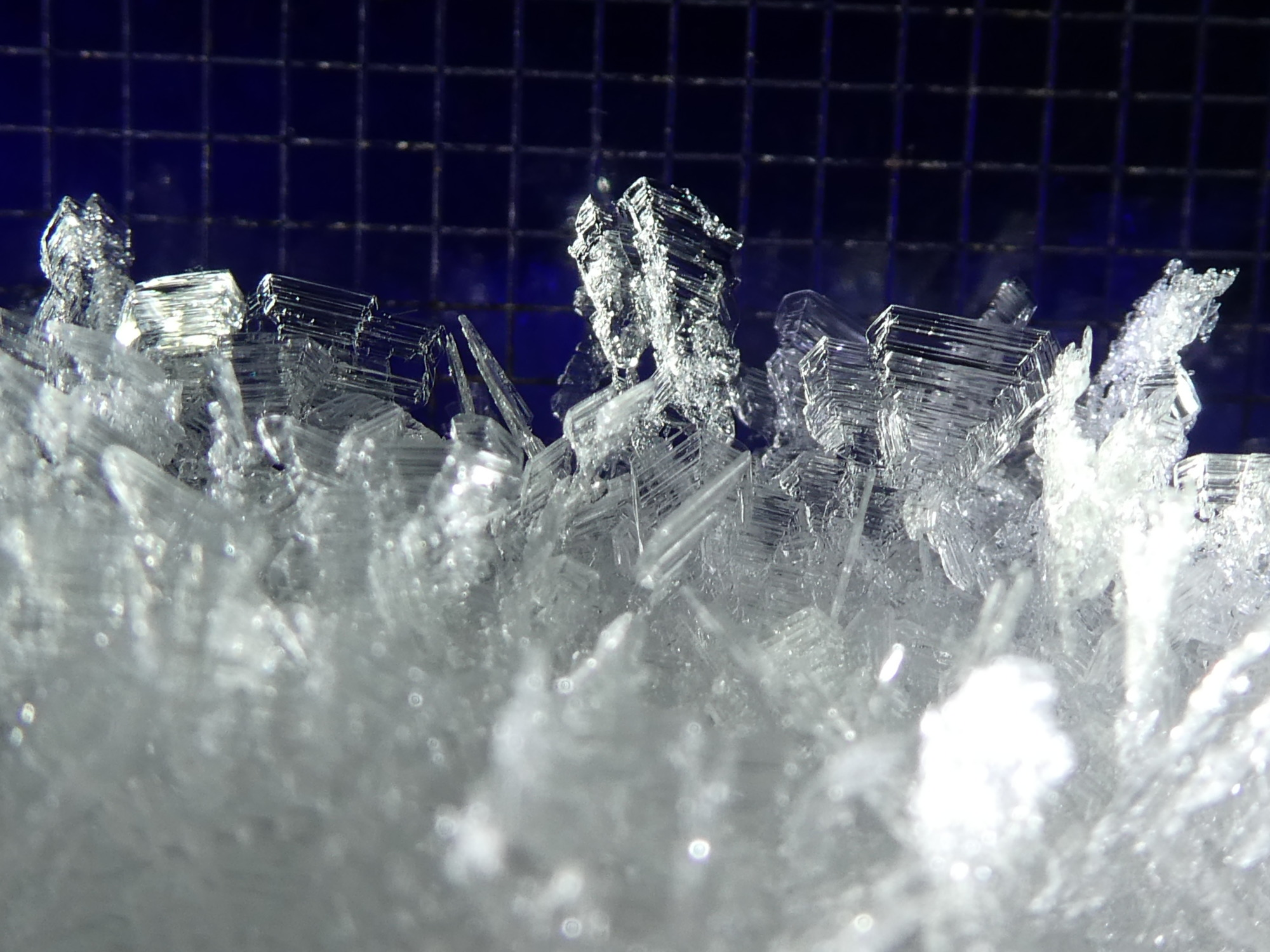
SWE accumulation at high elevations
Volume of snow is actually less due to less area for snow to accumulate on. SWE volume peaks at around 2000 m and then begins to decline as elevations get higher
What a warming climate means for precipitation trends?
More precipitation will fall as rain, and snowmelt will happen more quickly, dumping most of its mass in the spring rather than gradually over the summer.
Snow-climate problem
Snowpack doesn’t only change due to warming (storm tracks, precipitation intensity)
Snowpack has variability (across length scales, the winter season, from year to year)
Our measurement system struggles to know the amount of snowpack out there in the first place
Ways to show snow density
Mass of snow relative to density
Mass of snow relative to water content (how density for SWE is determined)
SWE = snow depth * % of snow relative to water
Passive microwave
Dry snow radiates energy, specifically long wave radiation. Satellites measure this, and the value is generally quite low, which means there is not much energy reaching the receiver (low temperature brightness, <1). When the snow becomes wet, however, the emissivity raises to 1, turning it into a black body; more energy is emitted up and the snow has a high TB. These spikes in the signal can be analyzed to show when snow is melting or not. Not very useful in the mountains
Satellites are used mainly for
determining snow covered areas at low, flat elevations
Ways to measure snow depth
Probes, stakes, boards, sonic rangers, lidar, cameras, structure from motion
Sonic ranger
An instrument that sends a sound wave that bounces off a surface and returns; this can be analyzed to determine how close or far away snow is
Issues: must know temp and density of air around you. Prone to errant readings
Structure from motion
Measuring snow depth from aerial imagery; taking a picture at one time versus another and seeing how much snow sfc rises or falls.
Issues: does not measure snow density
Types of SWE measurement
bulk mass of whole snowpack; weight method. Dig a snow pit, measuring density at each layer
snow coursing; plunging a tube into snowpack to measure depth, multiplying mass of the snow by the volume of the tube. Biased towards low elevation, designed for water resources
SNOTEL
Issues: not always representative of snow history in the region
SNOTEL
Snow telemetry. Pillow that measures weight of snowpack. As snow piles up on the pillow, its weight compresses the fluid in the precipitation gauge, increasing the hydrostatic pressure, which a sensor measures and records
Issues: rime formation on baffles, bridging and ice lenses, snow creep, blowing snow, location bias, sensitivity to temperature, inaccurate representation
